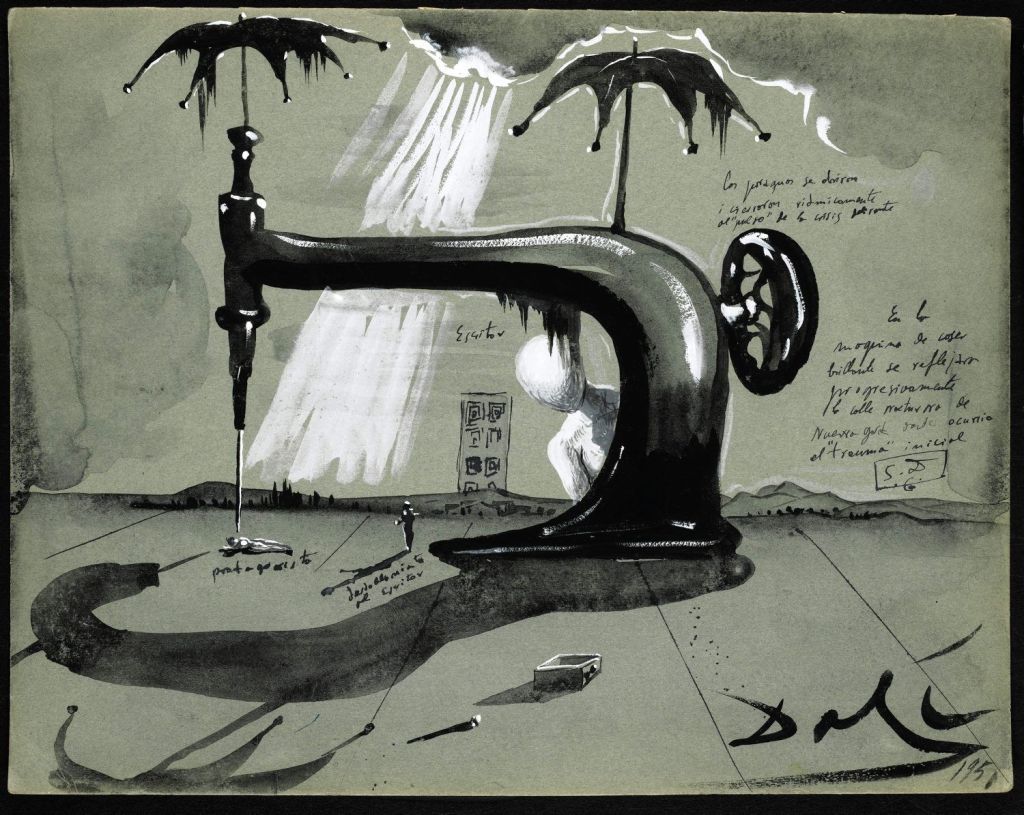Talking about ‘Thinking Like A Brick’: an online seminar with Luke Bennett for the Australian Association for Research in Education, 8.30am (UK time) Thursday 21 March 2024
March 6, 2024 Leave a comment

“As beautiful as the chance encounter of a sewing machine and an umbrella on an operating table”
Isidore Ducasse (Comte de Lautréamont), (1869) Les Chants de Maldoror
Sewing machines, umbrellas and operating tables have no obvious connection – and that’s why the Surrealists took inspiration from the Comte de Lautréamont: the juxtaposition of these items was unfathomable and unsettling (uncanny). But if those three items were to become co-located, they would reach their own accommodation. They would find a way of co-existing, but that search for a ‘spatial justice’ would not readily (except via Surrealist tickstery logics) mean much to us humans.
These were the kind of thoughts swirling around my mind 10 years ago whilst I struggled to write-up a book chapter which I’d been invited to contribute to a book entitled ‘Post-Human Research Practices in Education’ (2016, eds Taylor & Hughes).
Over the years a number of people seem to have been interested in what I wrote (and there’s a free copy here), and this has led to me being invited to discuss the chapter in a 1-hour online seminar hosted by the Australian Association for Research in Education, on 21 March 2024. Registration is here: https://www.aare.edu.au/sigs/qualitative-research-methodologies/decentring-the-human-in-qualitative-research-methodologies-seminar-series/
Here are my abstract and biog, as presented on that registration site:
Reflections on ‘Thinking like a brick: Posthumanism and building materials’
Abstract
In my essay contribution to Carol A. Taylor & Christina Hughes’ 2016 edited collection Posthuman Research Practices in Education (Palgrave) I set out to answer the question “How can we know of bricks, blocks and slabs in a posthuman way?” But the process of writing, and responding to that question, led me increasing to an ambivalent position, at least as regards the limits of posthumanism within education. Ultimately, I ended up having to distinguish between a ‘weak’ and a ‘strong’ posthumanism and concluded that only a ‘weak’ (and ‘thing-for-us’ rather than ‘thing-in-itself’) position was possible. My essay ended up a playful (but sincere) foray: drawing together the theoretical abstractions of transhumanism, object oriented ontology and material culture studies and setting them to work alongside prosaic encounters with building materials (to see what would happen in that encounter). In this session I will share my candid insights into that authorial journey, in doing so disassembling the integrity of my presented text and highlighting some of the ‘paths not taken’, and some of the roadblocks that I stumbled upon along the way, and how I struggled to deal with them. This deconstruction will ultimately deliver upon a positive motive: it will point to pragmatic ways in which a greater attentiveness to our relationships with things is needed and is – through a more openminded (and playful) pedagogy – possible. In doing so it will achieve my essay’s additional aim to “examine how we learn about, and pass on, the materiality of the world around us” – and why that “matters” (in the dual sense attributed to that word by Karen Barad in Meeting the Universe Halfway (2007, Duke University Press).
Brief Biography
Luke Bennett is currently an Associate Professor in the Department of the Natural & Built Environment at Sheffield Hallam University, UK. After a 17 year career as an environmental lawyer, Luke stepped into academia in 2007 to teach law to built environment students. Along the way he gained a PhD by publication (his published outputs being summated under the title ‘Interpretive Communities at work and play in the built environment’). Treating the materiality of the built environment as a negotiated text, across various field studies Luke looked at how – collectively – groups of professionals and lay-actors frame their relationships with places and the matter which composed them (variously urban trees, gravestones, ruined buildings, copper cables) using acquired cultural codings, like liability for accidents and hobby practices. Luke has continued to examine these themes through, academic publications (details here), his leadership of Sheffield Hallam University’s interdisciplinary ‘Space & Place Group’ (whose session recordings are here) and his bloggings about his investigations and ruminations here.
Image Source: Salvador Dalí, Sewing machine with umbrellas, scene shoot for a film project involving a writer and model, New York and Madrid (1951), gouache on cardboard, 25 x 32 cm via https://www.huffpost.com/entry/miami-spice_b_6229802
